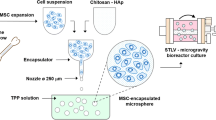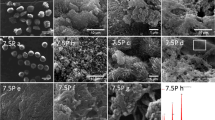Summary
Three-dimensional (3D) osteoblast cell cultures were obtained in rotating-wall vessels (RWV), simulating microgravity. Three types of bioactive microcarriers, specifically modified bioactive glass particles, bioceramic hollow microspheres, and biodegradable bioactive glass-polymer composite microspheres, were developed and used with osteblasts. The surfaces of composite microspheres fully transformed into bone apatite after 2-wk immersion in simulated physiological fluid, which demonstrated their bone-bonding ability. The motion of microcarriers in RWVs was photographically recorded and numerically analyzed. The trajectories of hollow microspheres showed that they migrated and eventually stayed around at the central region of the RWV. At their surfaces, shear stresses were low. In contrast, solid glass or polymer particles moved toward and finally bounced off the outer wall of the RWVs. Cell culture studies in the RW, using bone marrow stromal cells showed that the cells attached to and formed 3D aggregates with the hollow microspheres. Extracellular matrix and mineralization were observed in the aggregates. Cell culture studies also confirmed the ability of the composite microspheres to support 3D bone-like tissue formation. These data suggest that the new hollow bioceramic microspheres and degradable composite microspheres can be used as microcarriers for 3D bone tissue engineering in microgravity. They also have potential applications as drug delivery systems.
Similar content being viewed by others
References
Becker, J.L.; Prewett, T.L.; Spaulding, G.F., et al. Three-dimensional growth and differentiation of ovarian tumor cell line in high aspect rolating-wall vessel: morphologic and embryologic considerations. J. Cell. Biochem. 51:283–289; 1993.
Cherry, R.S.; Papoutsakis, E.T. Hydrodynamic effects on cells in agitated tissue culture reactors. Bioprocess Eng. 1:29–41; 1986.
Ducheyne, P. Stimulation of biological function with bioactive glass. MRS Bull. 23:43–49; 1998.
Ducheyne, P.; Cuckler, J.M. Bioactive ceramic prosthetic coatings [Review]. Clin. Orthop. Rel. Res. 276:102–114; 1992.
El-Ghannam, A.; Ducheyne, P.; Shapiro, I.M. Porous bioactive glass and hydroxyapatite ceramic affect bone cell function in vitro along different time lines. J. Biomed. Mater. Res. 36:167–180; 1997.
Freed, L.E.; Vunjak-Novakovic, G. Cultivation of cell-polymer tissue constructs in simulated microgravity. Biotech. Bioeng. 46:306–313. 1995.
Freed, L.E.; Vunjak-Novakovic, G. Tissue engineering of cartilage in space. Proc. Natl. Acad. Sci. USA 94(25):13,885–13,880; 1997.
Gao, H.; Ayyaswamy, P. S.; Ducheyne, P. Numerical simulation of global diffusive mass transfer in a rotating-wall bioreactor. In: Clegg, S., ed. Advances in heat and mass transfer in biotechnology. ASME International Mechanical Engineering Congress and Exposition, Dallas, TX; 1997a:59–68.
Gao, H.; Ayyaswamy, P.; Ducheyne, P. Dynamics of a microcarrier particle in the simulated microgravity environment of a rotating wall vessel. Microgravity Sci. Technol. X/3:154–165; 1997b.
Goodwin, T.J.; Jessup J.M.; Wolf, D.A. Morphological differentiation of colon carcinoma cell lines HT-29 and HT-29KM in rotating-wall vessels. J. Tissue Cult. Methods 28A:47–60; 1992.
Goodwin, T.J.; Prewett, T.L.; Wolf, D.A., et al. Reduced shear stress: a major component in the ability of mammalian tissue to form three-dimensional assemblies in simulated microgravity. J. Cell. Biochem. 51:301–311; 1993.
Hench, L.L., Bioactive ceramics. In: Ducheyne, P.; Lemons, J.E., ed. Bioceramics: material characteristics versus in vivo hehavior, New York: New York Academy of Science; 1988:54–71.
Hench, L.L.; Splinter, R.J.; Allen, W.C., et al. Bonding mechanisms at the interface of ceramic prosthetic materials. J. Biomed. Mater. Res. 2(1):117–141: 1971.
Hillsley, M.V.; Frangos, J.A. Alkaline phosphatase in osteoblasts is down-regulated by pulsatile fluid flow. Calcif., Tissue Int. 60:48–53; 1997.
Jessup, J.M.; Goodwin, T.J.; Spaulding, G. Prospects for use of microgravity-based bioreactors to study three-dimensional host-tumor interactions in human neoplasia. J. Cell. Biochem. 51:290–300; 1993.
Langer, R. New methods of drug delivery. Science 249:1527–1533; 1990.
Li, P.; Bakker, D.; van Blitterswijk, C.A. A bone-bonding polymer (Polyactive(R) 80/20) induces hydroxycarbonate apatite formation in vitro. J. Biomed. Mater. Res. 34:79–86; 1997.
Maniatopoulos, C.; Sodek, J.; Melcher, A. H. Bone formation in vitro by stromal cells obtained from bone marrow of young adult rats. Cell Tissue Res. 254:317–330; 1988.
Ohtsuki, C.; Kokubo, T.; Yamamuro, T. Mechanism of apatite formation on CaO-SiO2-P2O5 glasses in a simulated body-fluid. J. Non-Cryst. Solids 143:84–92; 1992.
Prewett, T.L.; Goodwin, T.J.; Spaulding, G.F. Three-dimensional modeling of T-24 human bladder carcinoma cell line: a new simulated microgravity culture vessel. J. Tissue Cult. methods 15:29–36; 1993.
Qiu, Q.; Ducheyne, P.; Ayyaswamy, P. Fabrication, characterization and evaluation of bioceramic bollow microspheres used as microcarriers for 3-D bone tissue formation in rotating bioreactors. Biomaterials 20:989–1001; 1999.
Qiu, Q.; Ducheyne, P.; Ayyaswamy, P. New bioactive, degradable composite microspheres as tissue engineering, substrates. J. Biomed. Mater. Res. 52(1):66–76; 2000.
Qiu, Q.; Ducheyne, P.; Gao, H., et al. Formation and differentiation of three-dimensional rat marrow stromal cell culture on microcarriers in a rotating-wall vessel. Tissue Eng. 4(1):19–34; 1998.
Reich, K.M.; McAllister, T.N.; Gudi, S., et al. Activation of G proteins mediates flow-induced prostaglandin E2 production in osteoblasts. Endocrinology 3:1014–1018; 1996.
Schwarz, R.P.; Goodwin, T.J.; Wolf, D.A. Cell culture for three-dimensional modeling in rotating-wall vessels: an applicatioe of simulated microgravity. J. Tissue Cult. Methods 14:51–58; 1992.
Smalt, R.; Mitchell, F.T.; Howard, R.L., et al. Induction of NO and prostaglandin E2 in osteoblasts by wall-shear stress but not mechanical strain. Am. J. Physiol. 273(4 Pt. 1):E751-E758; 1997.
Wolf, D.A.; Schwarz, R.P. Analysis of gravity-induced particle motion and fluid perfusion flow in the NASA-designed rotating zero-head-space tissue culture vessel. NASA Tech. Paper 3143:1–12; 1991.
Author information
Authors and Affiliations
Corresponding author
Rights and permissions
About this article
Cite this article
Qiu, QQ., Ducheyne, P. & Ayyaswamy, P.S. 3D Bone tissue engineered with bioactive microspheres in simulated microgravity. In Vitro Cell.Dev.Biol.-Animal 37, 157–165 (2001). https://doi.org/10.1290/1071-2690(2001)037<0157:BTEWBM>2.0.CO;2
Issue Date:
DOI: https://doi.org/10.1290/1071-2690(2001)037<0157:BTEWBM>2.0.CO;2




